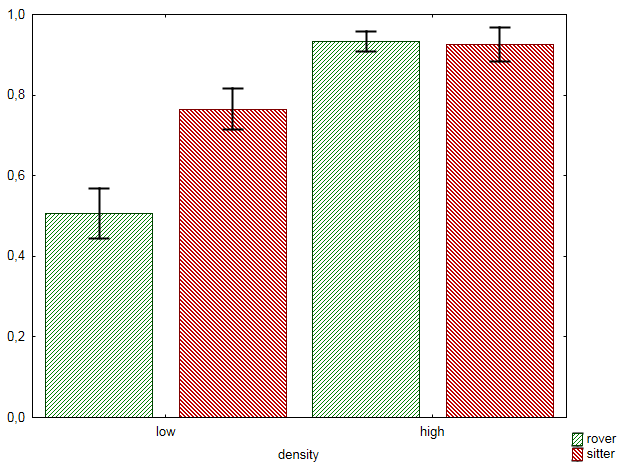![]() For our course this year I was planning a standard neurogenetic experiment. I hadn’t ever done this experiment in a course, yet, just two weeks ago I tried it once myself, with an N=1. The students would get two groups of Drosophila fruit fly larvae, rovers and sitters (they wouldn’t know which was which). About ten larvae from each group would be placed on one of two yeast patches on an agar plate. After 20 minutes, they would count the number of larvae in the first patch, the second patch and those in none of the patches, i.e, elsewhere on the plate:
For our course this year I was planning a standard neurogenetic experiment. I hadn’t ever done this experiment in a course, yet, just two weeks ago I tried it once myself, with an N=1. The students would get two groups of Drosophila fruit fly larvae, rovers and sitters (they wouldn’t know which was which). About ten larvae from each group would be placed on one of two yeast patches on an agar plate. After 20 minutes, they would count the number of larvae in the first patch, the second patch and those in none of the patches, i.e, elsewhere on the plate:

Classic experiment designed by Marla Sokolowski, the discoverer of the rover/sitter polymorphism
In the example above, the scores would be 3, 3 and 4 for the rovers and 10, 0, 0 for the sitters.
Yesterday morning, before the course, when I was collecting the vials for the experiment, I saw that I had an additional vial of each stock where I had forgotten to remove the parent flies, such that the vials were completely overcrowded. Remembering that my last slide in the lecture for the course was a result from Kaun et al. 2007, where the authors had discovered that the behavior of the larvae was dependent on food quality, I felt we should try and see if this overcrowding had already deteriorated the food enough to show the effect Kaun et al. had described: that rovers became more like sitters and didn’t leave the food patch they were placed in any more.
So I grabbed the two overcrowded vials and decided to try something that usually would be a recipe for disaster: in an experiment never tried on students, alter the conditions such that you wouldn’t know the outcome yourself. The plan was that in case we wouldn’t see a strong difference between the two strains, I’d go and fetch the two vials I had prepared with the correct density of larvae and hence proper food quality. With these latter flies, at least, we should see the difference between rovers and sitters. Here are the data the 12 students collected on the blackboard from the experiments done on a single afternoon:
One can already see from the numbers alone that the difference between the strains becomes very clear in the low-density case (blue) while it is less pronounced in the case of the overcrowded larvae (white). But because the result so clearly matches the results from Kaun et al, I’ve plotted the data and compared them side-by side.
First the data from Kaun et al. which show that with low food quality (15% – corresponding to our high-density larvae), rover and sitter larvae consume about the same amount of food and both more than with perfect quality food (100% – corresponding to our low density conditions):

Data from Kaun et al. 2007 on the effect of food quality of food intake in rover and sitter fruit flies.
As we didn’t measure food intake, but just the location of the larvae, we’ll take the percentage of larvae on the first patch as a measure of staying and feeding instead of leaving the patch and searching for another food patch. That way, we got an all but identical graph:
This replication provided an opportunity to emphasize two general points: first, it is highly unusual to reproduce previously published data with such ease and to such an astonishing degree. Second, I reiterated what I had already said during the lecture: there is no genetic determinism. Even humble fruit fly larvae show that different genotypes do not necessarily mean different fate – it depends strongly on the environment, if any genotypic differences manifest themselves in phenotypic differences.
Kaun, K., Riedl, C., Chakaborty-Chatterjee, M., Belay, A., Douglas, S., Gibbs, A., & Sokolowski, M. (2007). Natural variation in food acquisition mediated via a Drosophila cGMP-dependent protein kinase Journal of Experimental Biology, 210 (20), 3547-3558 DOI: 10.1242/jeb.006924

















Comments are closed.